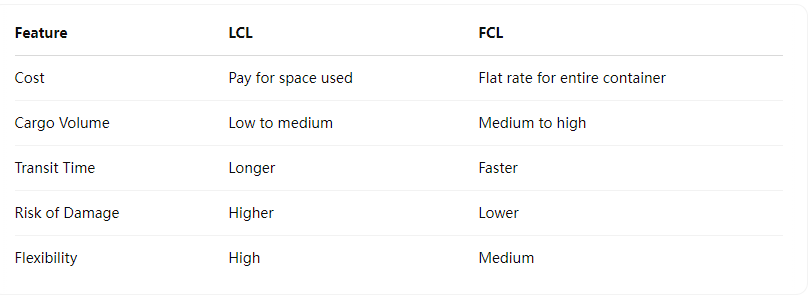If you have never been engaged in import business, if you need to buy a small amount of products from abroad as a sample order, then you must understand that LCL shipment
A Guide to Less than Container Load Logistics
In the world of international trade and global logistics, efficiency and cost-effectiveness are crucial. For small and medium-sized enterprises (SMEs) or businesses that don't require an entire shipping container for their goods, Less than Container Load (LCL) shipment presents an ideal solution. LCL shipping allows multiple consignees to share space in a single container, offering a flexible and economical alternative to Full Container Load (FCL) shipping.
What is LCL Shipment?
LCL stands for Less than Container Load. It refers to a shipping method in which cargo from multiple shippers is consolidated into one container. This method is used when a shipper does not have enough goods to fill a full 20-foot or 40-foot container. In this case, a freight forwarder or consolidator combines shipments from various clients into a single container bound for the same destination or a common transit point.
Once the container arrives at the destination port, it is deconsolidated, and each shipment is delivered to its respective consignee.
How LCL SHIPMENT Works
The LCL process involves several steps:
Booking and Pickup: The shipper books LCL freight through a freight forwarder, who arranges to pick up the cargo and take it to a consolidation warehouse.
Consolidation: At the warehouse, the cargo is grouped with other shipments headed to the same port or region.
Loading: All grouped cargo is loaded into a container and sealed before being shipped via ocean freight.
Transportation: The container travels on the vessel to the destination port.
Deconsolidation: At the destination, the container is opened, and each shipment is separated and sent to its respective consignee.
Final Delivery: The individual shipments are then delivered to their final destinations.
Benefits of LCL SHIPMENT
Cost-Effective: One of the main advantages of LCL SHIPMENT is the cost savings. Businesses only pay for the space they use in a container, which is far more affordable than renting a whole container for a smaller volume of goods.
Flexibility: LCL SHIPMENT offer more flexibility in terms of shipping schedule. Since you're not required to fill an entire container, you can ship smaller batches of goods more frequently.
Accessibility: LCL SHIPMENT makes international trade accessible to smaller companies that do not have large volumes of cargo, opening up global markets for startups and SMEs.
Inventory Management: With LCL, businesses can adopt a just-in-time inventory approach, reducing warehousing costs and improving cash flow.
Challenges of LCL SHIPMENT
Despite its benefits, LCL also comes with a few drawbacks:
Longer Transit Times: LCL shipments typically take longer than FCL because of the additional steps involved in consolidation and deconsolidation. Shipments may also be delayed if other cargo in the container causes hold-ups at customs.
Higher Risk of Damage: Since multiple shipments are packed into one container, there's an increased risk of damage or contamination from other goods.
Complex Documentation: The documentation process for LCL can be more complex compared to FCL, especially when multiple consignments are involved. Any error in one shipment’s documentation can potentially delay the entire container.
Increased Handling: More frequent handling during the loading, unloading, and sorting process increases the risk of loss or damage.
When to Choose LCL SHIPMENT
LCL SHIPMENT is ideal in the following scenarios:
When you have less than 15 cubic meters of cargo.
When speed is less critical than cost.
When you're testing a new market or shipping small samples.
When your supply chain allows for some flexibility in delivery times.
However, if you consistently ship larger volumes or require faster, more secure delivery, FCL might be a better option.
Tips for a Smooth LCL SHIPMENT Experience
Work with a Reliable Freight Forwarder: A trusted freight partner ensures your cargo is handled efficiently, and paperwork is completed correctly.
Proper Packaging: Ensure your goods are well-packaged and labeled to minimize the risk of damage or loss.
Understand Your Shipping Terms: Familiarize yourself with Incoterms (like FOB, CIF, etc.) to know who is responsible for what during the shipping process.
Plan Ahead: Since LCL shipments can be delayed by other consignees’ cargo, always build in extra time into your supply chain.
LCL vs. FCL: A Quick Comparison

LCL shipment plays a vital role in modern global logistics by making international trade more accessible, especially for businesses that don't need a full container. While it may involve more handling and longer transit times, the cost savings and flexibility it offers make it an attractive option for many. By understanding the process and working with reliable partners, businesses can take full advantage of what LCL shipping has to offer.
Whether you’re a small business owner exploring global markets or an established brand optimizing your supply chain, LCL shipping could be the smart logistics solution that helps you scale without overspending.
Lastly , if you are interested in about our products , and want to place a sample order . Remembering that tell us if you have an agent for LLCL shipment. And your shiping mark is necessary .

